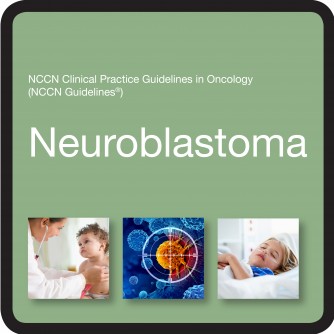NCCN Releases First Treatment Guidelines for Neuroblastoma
 The National Comprehensive Cancer Network (NCCN) published its first ever set of treatment recommendations pertaining to neuroblastoma, a type of solid tumor cancer that typically occurs in early childhood. According to the American Cancer Society, more than 700 cases diagnosed in the United States every year, however, research innovations have led to survival rates that are better than 90% for patients with low- and intermediate-risk neuroblastoma and around 50% for those with high-risk disease. Improving outcomes for patients with high-risk neuroblastoma and reducing long-term treatment effects for all patients remain areas of active research.
The National Comprehensive Cancer Network (NCCN) published its first ever set of treatment recommendations pertaining to neuroblastoma, a type of solid tumor cancer that typically occurs in early childhood. According to the American Cancer Society, more than 700 cases diagnosed in the United States every year, however, research innovations have led to survival rates that are better than 90% for patients with low- and intermediate-risk neuroblastoma and around 50% for those with high-risk disease. Improving outcomes for patients with high-risk neuroblastoma and reducing long-term treatment effects for all patients remain areas of active research.
“Neuroblastoma is a biologically and clinically heterogeneous cancer, which creates many challenges for those treating patients with this disease,” said Rochelle Bagatell, MD, Professor of Pediatrics and Solid Tumor Section Chief at Children's Hospital of Philadelphia, and Chair of the NCCN Clinical Practice Guidelines in Oncology (NCCN Guidelines) Panel for Neuroblastoma. “The NCCN Guidelines were designed to assist clinicians caring for children with neuroblastoma by providing key information regarding risk stratification and by summarizing the data that have led to the current approaches to therapy. As new clinical trial results become available and as therapies evolve, we will continue to support providers by updating the guidelines over time.”
Dr Bagatell will be presenting an on-demand online session on the latest updates for neuroblastoma in the new NCCN Guidelines as part of the NCCN 2024 Annual Conference on April 5 – 7.
“These new NCCN Guidelines for Neuroblastoma are the perfect platform for sharing how to think about this complicated disease and determine which categories of treatment should be considered for each individual patient,” explained Julie R. Park, MD, Chair, Department of Oncology, St. Jude Children's Research Hospital, Vice-Chair, NCCN Guidelines Panel for Neuroblastoma. “The guidelines break down how to incorporate the multi-disciplinary care that is needed, such as surgery or radiation, plus specific options for chemotherapy regimens.”
There are now 87 different NCCN Clinical Practice Guidelines in Oncology (NCCN Guidelines), covering nearly every type of cancer, plus screening, prevention, and supportive care. The NCCN Guidelines for Neuroblastoma are the 6th to focus specifically on treating pediatric cancer.
The NCCN Guidelines have a long history of providing treatment guidance that correlates with improved outcomes across numerous cancer types. The recommendations are determined by a multidisciplinary panel of experts from NCCN’s Member Institutions using the best available evidence and are updated at least once every year. By utilizing specialists with diverse areas of expertise and geographic locations, the panels are able to make sure the recommendations are thorough, representative, and understandable—particularly for clinicians who may not see patients with neuroblastoma very often. The NCCN Guidelines are intended as a resource for care providers and coverage determinations throughout the U.S. and around the world.
“We are particularly concerned with figuring out how to minimize treatment where possible,” said Dr Park. “We wanted to make it easy for providers to quickly recognize which patients can have positive outcomes while experiencing less toxicity. That means including a lot of information on diagnosis and delving into analysis for molecular drivers and aspects of immunotherapy.”